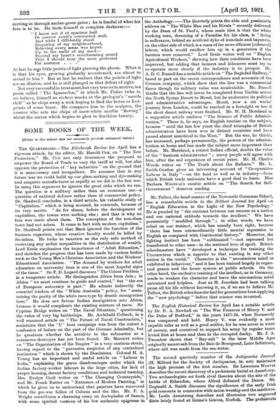POETS AND POETRY.
THE RUINED BARN.*
Tun greater part of " The Ruined Barn," the name poem of Mr. Fisher's collection, has already appeared in our columns, and our readers have had an opportunity of enjoying the exacti- tude and economy which he joins to its romantic flavour. It is certainly the best poem in the book ; some of the lines are very happy. For instance, nailed to the big door :—
" A wind-worn tassel of bone and feather That once in rapture of winged desire Hung on the air, free hovering fire."
Or, again, the description of a flight of birds :-
"Like careless letters scribbled on the sky
Or children's stitches in a wavering line A flock of plovers moves towards the hills. They change not with the years, they note no change Though men in new ways work and barns decay."
In many of the other poems there is a strong Wordsworthian flavour, notably in " The Stonebreaker," which also appeared in the Spectator four years ago.
"The Dream" is also successful. The dreamer finds himself
• The Ruined Barn, and other Poems. By A. Hugh Nailer. Loudon : Selwyn sad Blount. iss. 6d. net.]
moving in through amber-green gates ; he is fearful of what his fate is to be. He finds himself in complete darkness :— " I knew not if of spacious hall Or narrow tomb's contracted wall. And while I diffidently stood Ensuiring of my neighbourhood, Believing every sense was keyed Up to the nadir of my need— Beyond my heart's reverberating sound That I should hoar the most profound Far murmur . . ."
At last he seas little points of light piercing the gloom. What is it that his eyes, growing gradually accustomed, are about to reveal to him ? But at last he realizes that the points of light are an illusion, and he is still plunged in that defeat of sight.
Not very successful in treatment, but very true as to motive, is a poem called " The Iguanodon," in which Mr. Fisher (who is, we believe, himself an etcher) mocks at the geologist's " servile skill" as he chips away a rock hoping to find the bones or foot- prints of some beast. He compares him to the sculptor, the creator who sets the chips of snow-white marble "Sowing" about the statue which begins to glow in deathless beauty.



































 Previous page
Previous page